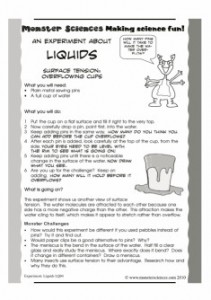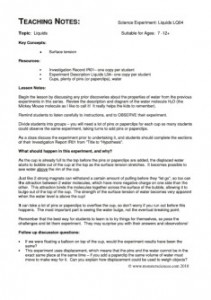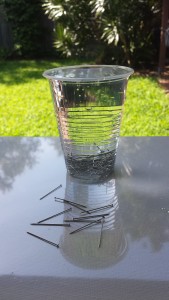Can you make water rise out of a glass?
 |
 |
Monster Sciences Liquids Science Experiment: Overflowing Cups – Surface Tension
What you will need:
- Plain metal sewing pins
- A full cup of water
What you will do:
- Put the cup on a flat surface and fill it right to the very top.
- Now carefully drop a pin, point first, into the water.
- Keep adding pins in the same way. How many do you think you can add before the cup overflows?
- After each pin is added, look carefully at the top of the cup, from the side. Your eyes need to be level with the rim to see what is going on!
- Keep adding pins until there is a noticeable change in the surface of the water. Now draw what you see.
- Are you up for the challenge? Keep on adding. How many will it hold before it overflows?
What is going on?
This experiment shows us another view of surface tension. The water molecules are attracted to each other because one side has a more negative charge than the other. This attraction makes the water cling to itself, which makes it appear to stretch rather than overflow.
Monster Challenges:
- How would this experiment be different if you used pebbles instead of pins? Try it and find out.
- Would paper clips be a good alternative to pins? Why?
- The meniscus is the bend in the surface of the water. Half fill a clear glass and really study the meniscus. Where exactly does it bend? Does it change in different containers? Draw a meniscus.
- Many insects use surface tension to their advantage. Research how and why they do this.
Teaching Notes: Monster Sciences Experiment: Liquids LQ04
Topic:
Liquids
Key Concepts:
Surface tension
Resources:
- Investigation Record IR01– one copy per student
- Experiment Description Liquids L04– one copy per student
- Cups, plenty of pins (or paperclips), water
Lesson Notes:
Begin the lesson by discussing any prior discoveries about the properties of water from the previous experiments in this series. Review the description and diagram of the water molecule H2O (the Mickey Mouse molecule as I like to call it! It really helps the kids to remember).
Remind students to listen carefully to instructions, and to OBSERVE their experiment.
Divide students into groups – you will need a lot of pins or paperclips for each cup so many students could observe the same experiment, taking turns to add pins or paperclips.
As a class discuss the experiment prior to undertaking it, and students should complete the sections of their Investigation Report IR01 from ”Title to “Hypothesis”.
What should happen in this experiment, and why?
As the cup is already full to the top before the pins or paperclips are added, the displaced water starts to bubble out of the cup at the top as the surface tension stretches. It becomes possible to see water above the rim of the cup.
Just like 2 strong magnets can withstand a certain amount of pulling before they “let go”, so too can the attraction between 2 water molecules, which have more negative charge on one side than the other. This attraction binds the molecules together across the surface of the bubble, allowing it to bulge out of the top of the cup. The strength of the surface tension of water becomes very apparent when the water level is above the cup!
It can take a lot of pins or paperclips to overflow the cup, so don’t worry if you run out before this happens. The most important part is seeing the water bulge, not the eventual breaking point.
Remember that the best way for students to learn is to try things for themselves, so pose the challenges and let them experiment. They may surprise you with their answers and observations!
Follow up discussion questions:
- If we were floating a balloon on top of the cup, would the experiment results have been the same?
- This experiment uses displacement, which means that the pins and the water cannot be in the exact same place at the same time – if you add a paperclip the same volume of water must move to make way for it. Can you explain how displacement could be used to weigh objects?
Get this experiment here or as part of a bundle of Surface Tension Experiments here.




